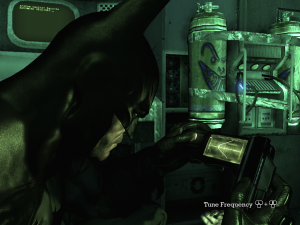Arkham Asylum: Bad Guys
For all the stylistic changes that Batman has gone through over the years, one thing has always been constant: the villains are the best part. Let’s take a look at how Batman: Arkham Asylum uses them. It does a surprisingly good job of assigning each of them a distinct role in both the story and the gameplay.
First and foremost is of course the Joker, the prime mover of the entire plot. The game opens with Batman delivering him back to Arkham after one of his many escapes, and although he disappears soon afterward, his presence is felt throughout the rest of the game. Even when he’s not hijacking security monitors to taunt Batman or delivering orders to his goons over the PA system, he’s a constant object of attention, as the goons discuss him or Batman makes discoveries about his plans. He’s the game’s GLaDOS, its Andrew Ryan. As such, I don’t expect a direct confrontation with him until the very end.
Since the Joker is thus consistently absent, Harley Quinn acts as his lieutenant on the scene, making recurring appearances wherever the designers want you to feel like you’re getting close to achieving your goals only to dash hope away. I’ve had an extended confrontation with her that I take to be the Harley Quinn boss fight — I suppose she could show up again later if someone lets her out of the very secure cell Batman locks her in, but if so, it’ll be kind of anticlimactic. The interesting thing is that the confrontation doesn’t involve fighting her directly — it’s more a fight that she directs, acting as what 4th edition D&D calls a “controller”. The writers seem to have a rule against hitting girls.
The first villain you meet who isn’t directly involved in the Joker’s plan is Victor Zsasz. As far as I’m aware, this is his first appearance outside the comics 1[UPDATE 16 January 2011] Shows how little I know! Not only does he make a brief appearance in the movie Batman Begins, he has no fewer than three videogame appearances predating Arkham Asylum. ; I was vaguely aware of his existence, but I’m not sure why. His deal is that he’s a serial killer, but not a flamboyant one like the Joker. He doesn’t even have a costume. He has a gimmick of cutting tally-marks into his skin for each of his victims, but that’s it. I suppose he’s useful to the writers of the comics when Batman is going through one of his periods of fighting normal, realistic crime. His role in the game, though, is to teach the player stealth mechanics. The first time you encounter him, he’s simply escaped from his cell in the chaos, and is holding off the guards by threatening to kill a hostage the moment anyone enters the room — so you have to take him down without being seen. He doesn’t stay down, though; I think the Joker finds him after you leave and releases him again. In the second encounter, he has another hostage, but can’t restrain himself from killing her for very long, so that imposes a time limit that forces you to use different techniques.
Bane is also an educational boss. The Joker’s plot involves turning his henchmen into an army of monsters by means of a newly-developed drug derived from Bane’s strength-enhancing “Venom”. I’ve encountered several of these mesomorphic abominations by now. They’re basically the sort of classic miniboss that charges into walls and becomes temporarily stunned and vulnerable, but with the twist that they only crash into the wall if you disorient them with a batarang to the noggin while they’re charging. Anyway, the fight with Bane is the tutorial for this. I have to feel a little sad for Bane; he’s fallen pretty far. As originally conceived, he’s Batman’s equal: polymath, master tactician, the only person with enough strength of will to use Venom and survive. But outside of the comics, he’s basically just a strongman in a wrestling mask who can be defeated by unplugging a hose. In this game, he at least gets to brag about having defeated Batman once (something the Schumacher and Animated Series versions of the character never managed), but he’s still just the Joker’s patsy.
But the game does give us one monster that Batman just plain can’t beat in a fight, and that’s Killer Croc. You can run away from him, you can temporarily disable him, and ultimately you can lead him into a trap, but going toe-to-toe with him isn’t even an option. If you try, game over. Croc is established as a lurking menace early on, glimpsed through a reinforced door long before the story takes you through his turf. He lives in the sewer under the asylum; the asylum guards throw meat down to him from time to time but otherwise leave him alone and count themselves lucky that they don’t have to get any closer to him. As such, he may not even really understand that anything has changed in the world above.
Similarly, the Scarecrow’s recurring appearances aren’t really boss fights in the conventional sense. They’re bad drug trips, and they’re by far my favorite parts of the game. Each encounter with him culminates a stealth/platforming sequence with a gigantic hallucinated Scarecrow towering over you, searching for you with deadly gaze. But that’s not the good part. Before you get to the platforming, you get a set-piece, a just-barely-interactive sequence comparable to walking through a carnival haunted house, but one that’s personalized to Bruce Wayne, themed around powerlessness and dead parents. These bits start with small but clear cues in the form of unsettling changes to the environment, like a Nightmare on Elm Street dream sequence — in one case, the first hint that I was hallucinating was that the location name of one room in Arkham Mansion had changed from “Library” to “Wayne Manor”. The final encounter simulates a crash and reboot of the console. This is perhaps less effective if you’re playing under Windows (I know what my machine looks like when it wigs out and it doesn’t look like that), but still brings it into that creepy Metal Gear Solid 2 territory where the game escapes from its established boundaries and addresses the player rather than the player character.
Poison Ivy is the big surprise. Not that it’s a surprise she’s in the game — you figure she’s going to show up as soon as you see a building labeled “Botanical Garden” on the map. The surprise is that she’s the dominant force for about half the story. When you first see her, she’s still imprisoned and helpless in an airtight glass case, distraught because she can feel the pain of the genetically-modified plants that are the source of Joker’s monster drug. She persuades Harley Quinn to release her, which is foolish on Harley’s part, because she has it in for the Joker as much as for Batman. Her chief effect in the game is altering the terrain, making huge roots and tendrils block the passageways you’ve come to expect, forcing you to find alternate routes, and generally causing more havoc and destruction than the Joker did when he took over. The Joker redecorated a bit, defacing statues and putting a mural of himself around one of the main doorways (the opening being his mouth), but Ivy is causing earthquakes. When you finally get to face off with her in one of the game’s genuine boss fights, the game once again asserts its no-hitting-girls policy by having her pilot a huge mecha-like flowering plant that you can hit instead.
That leaves the Riddler, who I’ve mentioned before. The Riddler isn’t so much a character in the story as a delivery device for collectibles and other optional challenges; I don’t expect to actually fight him, because eliminating him from the story would break the game mechanics. The game has some light RPG stuff going on, with Batman leveling up and getting new abilities and upgrades with experience (even though you’d think he must be level 20 in everything already). And, although you get experience for winning fights and for advancing the story, the safest way to level up is by solving the Riddler’s puzzles, which mainly means finding his question-mark-shaped trophies, which are scattered in inconvenient spots throughout the whole gameworld. Sometimes they’re in useless fake ducts that don’t go anywhere. Sometimes they’re sealed behind very old brick walls or other places that he couldn’t possibly have had access to. There’s nothing that makes in-world sense about this, but then, Arkham isn’t a sensible place.
That’s all I’ve seen so far, and I think I’m very close to the end of the game now. Certain of the Riddler’s things unlock character bios of major and minor characters from Batman continuity, including several villains I had never heard of, such as Humpty Dumpty and the Ratcatcher. But I doubt I’ll be seeing them.
| ↑1 | [UPDATE 16 January 2011] Shows how little I know! Not only does he make a brief appearance in the movie Batman Begins, he has no fewer than three videogame appearances predating Arkham Asylum. |
|---|
 Comments(1)
Comments(1)
